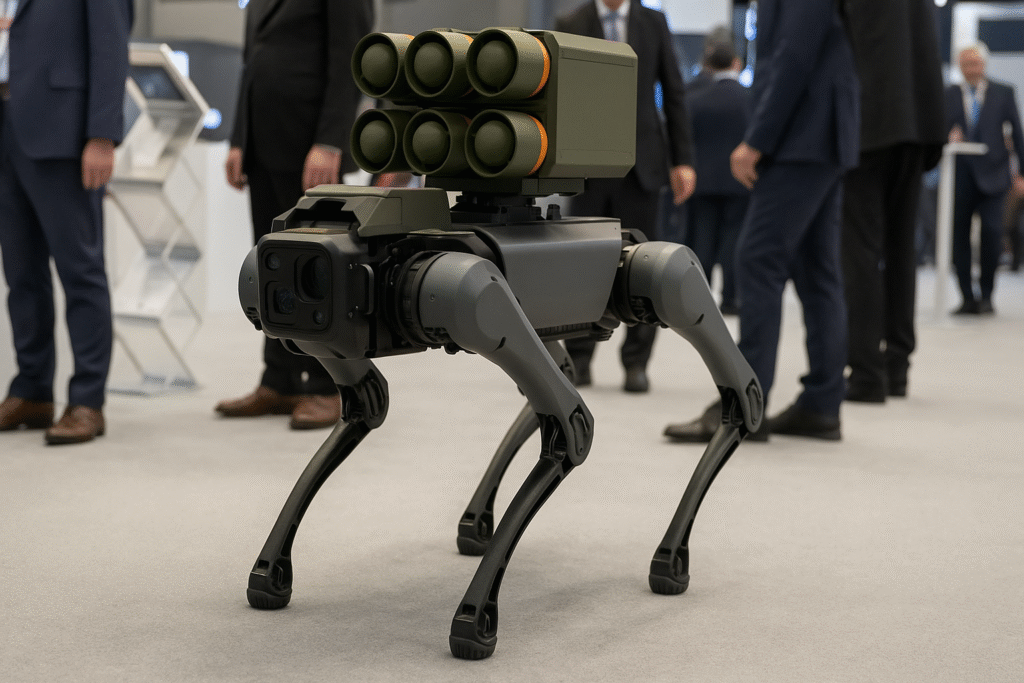In a striking demonstration of military innovation, Türkiye has unveiled Koz a missile firing robot dog that could reshape the very nature of ground combat. Unveiled at the 2025 International Defence Industry Fair (IDEF) in Istanbul, Koz marks the first time a robotic quadruped has been equipped with guided missile launching capabilities.
Developed by Türkiye’s leading defense firm Roketsan, Koz blends artificial intelligence, robotics, and advanced munitions in a way the world has never seen before. Beyond its intimidating mechanical appearance, Koz symbolizes Türkiye’s growing prowess in autonomous warfare.
A Mechanical Canine with Teeth: What Makes Koz a Game Changer?
Unlike other robotic units used for logistics or surveillance, Koz can walk, run, crouch, and fire all autonomously. Armed with METE, a lightweight precision guided missile developed by Roketsan, this missile firing robot dog is designed for close quarters combat, border security, and anti terror operations in both urban and mountainous terrain.
Dr. Haluk Görgün, the head of Türkiye’s Presidency of Defence Industries (SSB), said, Koz is not just a robot it’s a statement of technological independence and tactical evolution. It minimizes risks to our soldiers while maximizing impact on the battlefield.
From AI assisted navigation to target recognition via thermal sensors, Koz is capable of functioning independently or under remote control, enabling it to strike without exposing human operators to danger.
Military Analysts Sound Off
Retired Rear Admiral Cihat Yayci, a renowned defense strategist and professor at Istanbul’s Topkapi University, considers Koz a turning point in asymmetric warfare. We are looking at a missile firing robot dog that could be deployed in environments too dangerous for human troops tunnels, dense forests, urban conflict zones.
This changes everything. Yayci further emphasized that Koz gives Türkiye a unique edge in developing lethal autonomous weapons systems that are compact, affordable, and mission flexible especially important for countries facing hybrid warfare and irregular threats.
Combat Simulation at IDEF 2025
At IDEF, Koz was tested in a controlled simulation designed to mimic an urban combat scenario. The objective was to neutralize an enemy target holed up inside a two story building. Koz navigated through rubble and staircases using lidar and infrared mapping.
Upon detecting the heat signature of a simulated enemy, it locked onto the target. With a single guided METE missile, it completed the mission in under 5 minutes. Zero human soldiers were exposed during the operation. Observers from NATO and several foreign defense attachés were visibly impressed, describing the demonstration as decisive and technically astonishing.
Ethical Considerations and Global Impact
The introduction of a missile firing robot dog raises ethical questions surrounding the use of autonomous lethal force. Should machines be allowed to kill? Should there always be a human in the loop? While some critics caution against a fully autonomous battlefield, Turkish officials insist Koz is designed with safety protocols and requires human authorization before launching an attack.
Defense analyst Ayse Demir commented, What Türkiye is doing is not about replacing soldiers. It’s about protecting them. Koz can perform tasks that are too risky for humans while operating under strict command protocols. Nonetheless, as similar technologies emerge globally from the U.S Ghost Robotics to China’s robotic weapon platforms the arms race in autonomous systems is clearly accelerating.
More Than a Prototype
Though Koz is still in its testing phase, Roketsan plans to scale production in 2026 and deploy the units for real world field operations. The design will reportedly allow for different payload modules, including surveillance kits, chemical detection sensors, and additional munitions.
Türkiye’s defense vision aligns with its strategic goal of achieving full independence in military technology by 2030. Koz is not just a machine it’s a symbol of that ambition. The introduction of Koz, the world’s first missile firing robot dog, is not just a milestone for Türkiye it’s a global signal that the future battlefield will be shared between humans and machines.
With its unique combination of mobility, precision, and lethal capabilities, Koz has opened a new chapter in defense strategy. Whether praised as a marvel or scrutinized as a moral dilemma, one thing is clear: the age of robotic warfare has arrived, and Türkiye is leading the charge.

